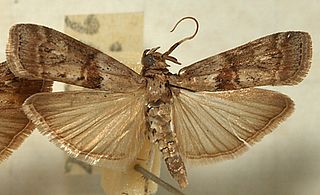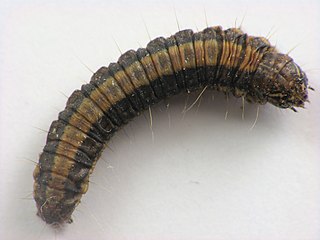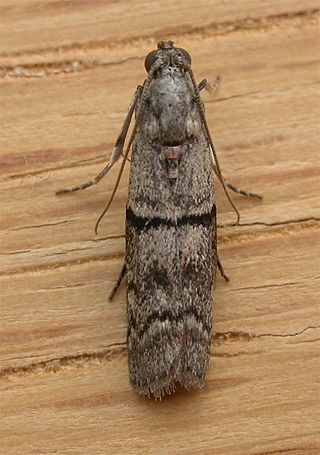
Crambidae comprises the grass moth family of lepidopterans. They are variable in appearance, with the nominal subfamily Crambinae taking up closely folded postures on grass stems where they are inconspicuous, while other subfamilies include brightly coloured and patterned insects that rest in wing-spread attitudes.

The Pyralidae, commonly called pyralid moths, snout moths or grass moths, are a family of Lepidoptera in the ditrysian superfamily Pyraloidea. In many classifications, the grass moths (Crambidae) are included in the Pyralidae as a subfamily, making the combined group one of the largest families in the Lepidoptera. The latest review by Eugene G. Munroe and Maria Alma Solis retain the Crambidae as a full family of Pyraloidea.

The Pyralinae are the typical subfamily of snout moths and occur essentially worldwide, in some cases aided by involuntary introduction by humans. They are rather rare in the Americas however, and their diversity in the Australian region is also limited. Altogether, this subfamily includes about 900 described species, but new ones continue to be discovered. Like many of their relatives in the superfamily Pyraloidea, the caterpillar larvae of many Pyralinae – and in some cases even the adults – have evolved the ability to use unusual foods for nutrition; a few of these can become harmful to humans as pests of stored goods.

Phycita is a genus of small moths belonging to the snout moth family (Pyralidae). They are the type genus of their tribe Phycitini and of the huge snout moth subfamily Phycitinae.

The Galleriinae are a subfamily of snout moths and occur essentially worldwide, in some cases aided by involuntary introduction by humans. This subfamily includes the wax moths, whose caterpillars (waxworms) are bred on a commercial scale as food for pets and as fishing bait; in the wild, these and other species of Galleriinae may also be harmful to humans as pests.

The Chrysauginae are a subfamily of snout moths. They are primarily Neotropical and include about 400 described species.

The Epipaschiinae are a subfamily of snout moths. More than 720 species are known today, which are found mainly in the tropics and subtropics. Some occur in temperate regions, but the subfamily is apparently completely absent from Europe, at least as native species. A few Epipaschiinae are crop pests that may occasionally become economically significant.

Homoeosoma is a genus of moths of the family Pyralidae.
Elasmopalpus is a snout moth genus in the subfamily Phycitinae described by Émile Blanchard in 1852. The genus is restricted to the Americas and currently comprises three species: the type species E. angustellus, described by Blanchard together with the genus, E. corrientellus Ragonot, 1888, and E. lignosellus, a pest species of Poaceae and Fabaceae crops that is widespread throughout the Americas. Elasmopalpus is considered to be closely related to the genus Ufa.

Dioryctria is a genus of snout moths. It was described by Philipp Christoph Zeller in 1846.

The Phycitini are a tribe of moths of the family Pyralidae.
Dioryctria mongolicella is a species of snout moth in the genus Dioryctria. It was described by Wang and Sung in 1982, and is known from north-eastern China and Mongolia.
Dioryctria resiniphila is a species of snout moth in the genus Dioryctria. It was described by Segerer and Pröse, in 1997, and it was described from Greece. It was recorded from China in 2009.
Dioryctria taedivorella, the lesser loblolly pineconeworm moth, is a species of snout moth in the genus Dioryctria. It was described by Herbert H. Neunzig and Nancy Antoine Leidy in 1989, and is known from North America, where it is found from eastern Virginia and North Carolina to northern Alabama and Mississippi.

The Anerastiini are a tribe of moths of the family Pyralidae.

Zophodia is a genus of snout moths in the subfamily Phycitinae. It was erected by Jacob Hübner in 1825.

Hypargyria is a genus of snout moths. It was described by Émile Louis Ragonot in 1888.
Peadus is a genus of snout moths.
Ufa is a moth genus in the subfamily Phycitinae of the family Pyralidae. The genus is distributed in the Americas. While sharing certain morphological characters in the female genitalia with Adelphia, Ufa appears closest related to Elasmopalpus.
Elasmopalpus corrientellus is a species of snout moths in the diverse subfamily Phycitinae. It was described by Émile Louis Ragonot in 1888 from a female specimen collected in the eponymous city of Corrientes in Northern Argentina. The species is considered misplaced in Elasmopalpus, but it is currently not clear to which genus it should be transferred.

















